Subjects:
- Indirect and direct injection
- Fuel pressure control with indirect injection
- Injection strategy multipoint injection
- Electromagnetic Injector (MPI)
- Piezo injector (DI)
- Direct Injection Injection Strategies
- Double injection
- Measuring voltage and current on a multipoint injector
- Injection time relative to crankshaft position
- Current limit ECU
- Determination of the required amount of fuel
- VE table
- AFR table
Indirect and direct injection:
The types of injection systems of a gasoline engine are divided into indirect injection for the throttle, indirect injection per cylinder and direct high-pressure injection. These different injection systems are explained in the paragraphs on this page.
Indirect injection:
An injector is located in front of the gas valve. The fuel is sprayed against the gas valve, where it mixes with the air flowing past. The major drawback is that there is no accurate fuel metering per cylinder; one cylinder always gets a little more or less than the other. The system is therefore not adjustable and is therefore no longer used with regard to environmental requirements. This system is also called central injection (Monopoint).
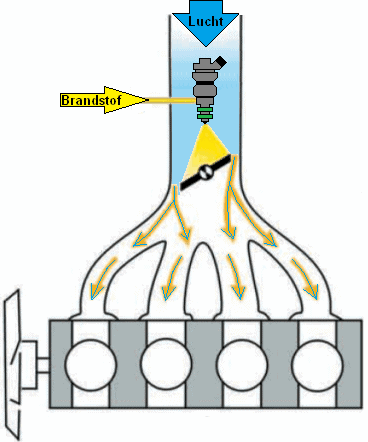
Indirect injection:
Each cylinder has its own injector. The injector injects the fuel into the intake valve. In this system, too, the flowing air ensures mixing before the air-fuel mixture enters the combustion chamber. The advantage over indirect injection is that the amount of fuel can be regulated much more accurately. This system is also known as MPI (MultiPoint Injection) or PFI (Port Fuel Injection).
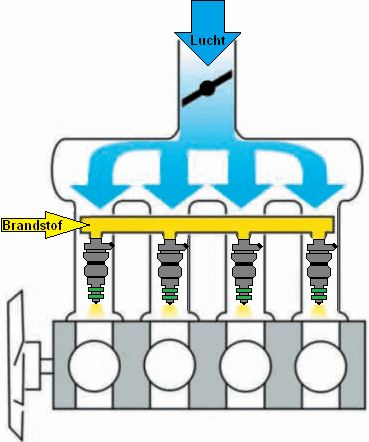
Direct injection:
The injectors for DI (Direct Injection) or DISI (Direct Injection Spark Ignition) are located next to the spark plug, at the top of the combustion chamber. The fuel is injected through this injector at a high pressure of approx. 200 bar during the intake stroke. The major advantages of this system are that the amount of fuel can take place even more accurately, that multiple injections can be made during the intake stroke and that the air-fuel mixture is cooler. This makes it possible for manufacturers to increase the compression ratio of the engine. The injector can be designed as a Piezo or a magnetic coil injector.
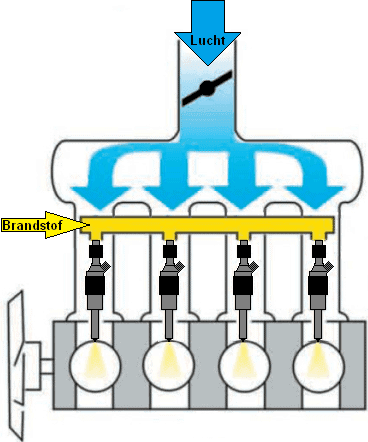
DI requires higher injection pressures than MPI/PFI because the injection takes place during the compression stroke; the fuel must be sufficiently atomized while the air in the cylinder is compressed. That is why there is a separate high-pressure pump at DI. The high pressure pump builds a fuel pressure in the fuel gallery. The injectors are attached to this fuel gallery with pipes. As soon as the engine management sends a signal to the injector, it will open and close at the desired time.
The advantages of DI compared to PFI include:
- More accurate injection;
- Multiple injections possible;
- Injection time can be adjusted;
- Higher effective pressure above the piston (allowing for downsizing with a higher compression ratio);
- Lower fuel consumption, lower CO2 emissions.
The disadvantages include:
- Higher system costs due to a high-pressure fuel pump, advanced injectors, more complex cylinder head;
- Increased soot emissions (PM emissions);
- Direct injection into the combustion chamber provides cooling instead of the necessary heat for the evaporation of the fuel.
A double injection engine takes advantage of both systems. Direct and indirect injection can switch according to the operating conditions. The operation and application of double injection is described in the section of the same name on this page.
Fuel pressure regulation with indirect injection:
Constant fuel pressure is a precondition for accurate fuel injection control. The fuel pressure (rail pressure) prevails at the top of the injector and the intake manifold pressure at the bottom. The pressure in the intake manifold varies with a varying engine load and will affect the fuel pressure difference and thus the injection quantity without a pressure regulator. That is why we use a fuel pressure regulator. In this section, we delve into the operation and purpose of this controller.
The figure below shows the components of an indirect injection petrol engine with multi-point injection. We look at the fuel flow from the pump in the tank to the injector.
When the ECU controls the fuel pump relay, the pump kicks in. The pump draws the fuel from as low a part as possible into the fuel tank and forces the fuel flow towards the fuel filter. Dirt particles in the fuel remain in the filter material. The filtered fuel then arrives at the fuel gallery. In most cases, the fuel gallery is fitted directly to the injector input.
There is a constant pressure in the fuel gallery: only when the injector is electrically controlled by the ECU (see the blue wire) does the injector open and the fuel is injected into the inlet manifold on the open inlet valve. The amount of fuel injected depends on:
- the injection time (determined by the ECU by lengthening or shortening the injection signal);
- the fuel pressure (with an injection time of 2 milliseconds, if the fuel pressure is too high, the injector injects more than the ECU has calculated).
The fuel pressure in the fuel gallery (also called rail pressure) is adjusted according to the engine load. We will go into this in more detail in the next section.
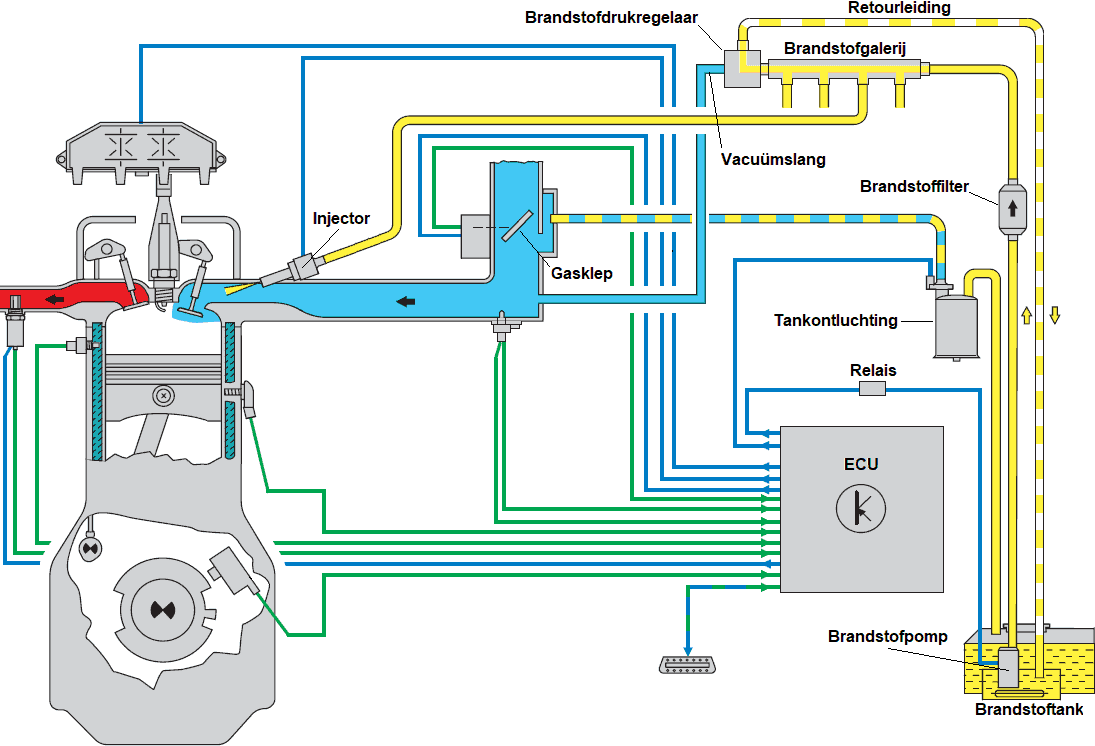
Without using a pressure regulator, the following situations arise:
- At idle speed, the higher vacuum (i.e. a low air pressure) in the intake manifold would result in an undesirably higher fuel pressure;
- When accelerating, there is less or even hardly any vacuum (full load) and the fuel pressure would drop, while a higher fuel pressure is desired.
The fuel pressure regulator increases or decreases the fuel pressure in the fuel gallery according to the air pressure in the intake manifold. The fuel pressure regulator can be considered as a dynamic valve, which allows an opening between the supply line from the fuel pump with the return line.
On the right we see a fuel pressure diagram where the relative pressure difference in all conditions (idle, part load and full load) thanks to the pressure regulator is 4 bar.
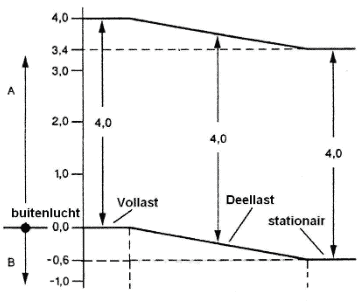
The explanation below refers to the illustrations in which the pressure regulator can be seen in the situation without and with vacuum. On the right is a Bosch fuel pressure regulator, which has been used by several car manufacturers.
Without vacuum (left):
The pressure regulator is closed at rest: the spring compresses the diaphragm, preventing the supplied fuel from reaching the return line.
With vacuum (center):
When the pressure above the diaphragm is reduced, the fuel pressure on the supply side pushes the diaphragm upwards against the spring force. An opening is created through which the fuel supplied is discharged through the return line to the fuel tank.
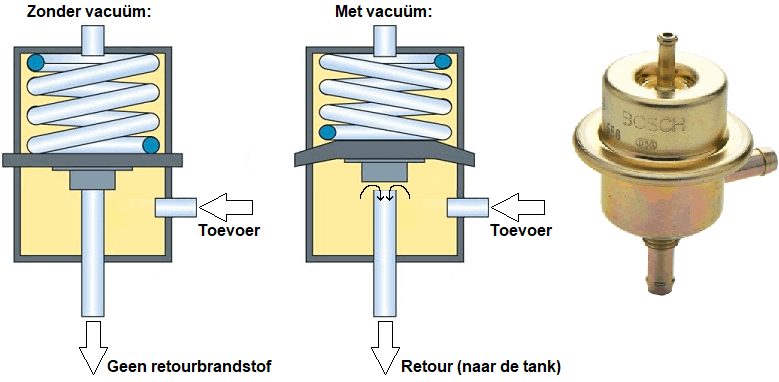
Injection strategy multipoint injection:
With (indirect) multipoint injection, three different injection methods are used:
- Simultaneous: all cylinders inject at the same time.
- Groupwise: the injection takes place per group; there is a distinction between one or more groups.
- Sequential: each injector is controlled individually and therefore has its own injection moment.
The engine management system in the figure below illustrates group injection. The injectors of cylinders 1 and 2 have a common power supply (red) and are both connected to ground at the same time (green). The injectors of cylinders 3 and 4 are the same, but are controlled separately from cylinders 1 and 2.
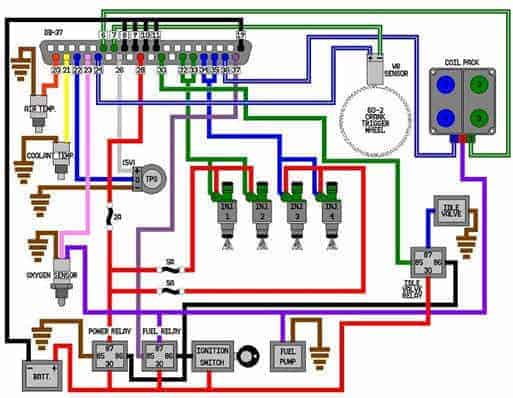
Electromagnetic Injector (MPI):
The electromagnetic injector is used on many petrol engines that do not use (direct) high-pressure injection with a separate high-pressure pump. The fuel is at a constant pressure of 1 bar at the inlet of the injector. Fuel pressure is provided by the fuel pump in the tank. With multipoint injection (described later on the page), each cylinder has its own injector. This injector is mounted in the intake manifold and injects fuel with a pressure of up to 6 bar before the valve opens. The fuel will then have sufficient time to mix with all the oxygen (indicated in the picture as the dark blue arrow) entering the cylinder when the intake valve begins to open.
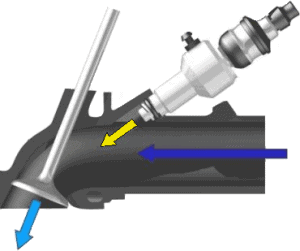
The engine control unit looks at the crankshaft position to control injection and ignition timing. Based on several factors (engine and ambient temperature, load, speed, etc., it will give a signal to the injector at the right time to open. The plug of this injector contains two wires. One wire has a constant plus of around 14 volts The other wire is grounded by the ECU to allow current to flow through the injector coil When the coil is sufficiently charged the injector needle opens against the spring force When the actuation stops a spring compresses the injector needle is returned. The fuel supply is then shut off. The moment the control stops, the coil is still electrically charged. The energy in the coil forms into an induction peak, which can be observed on the oscilloscope. The induction voltage is briefly around the 60 volts.
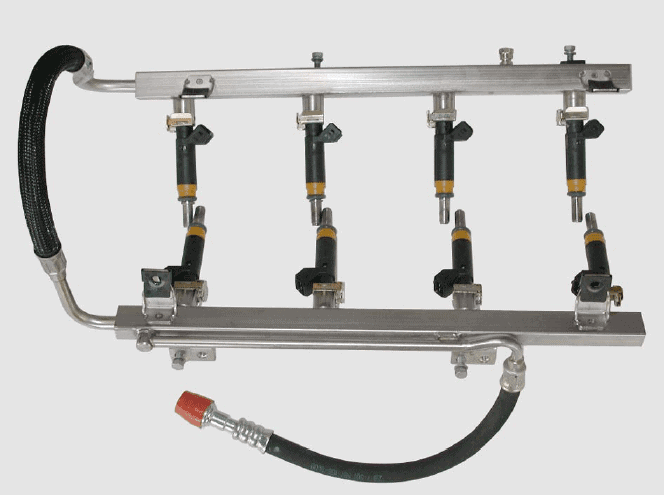
These injectors are fueled by the fuel rail (also known as the fuel gallery). The booster pump in the fuel tank provides the pressure in the fuel rail. The fuel pressure in the rail is constant (approx. 4 bar). Because the pressure is so low, the injectors are secured with a locking clip and a seal o-ring. Especially in older cars where the system is disassembled, it is wise to replace the O-rings before assembly.
The housing of an injector is usually made of plastic. At the top of the housing we find the plug connection, which is internally connected to the coil. There is a rubber O-ring at the top over which the fuel gallery slides. O-rings or Teflon sealing rings can be found at the bottom. An O-ring is mainly used in MPI injectors with low-pressure injection, while Teflon rings can be found in engines with high-pressure injection, such as an FSI engine.
The coil is wound around the core of the injector. In the attached image the coil is highlighted in red. In the center of the injector, also internal to the coil, is a plunger. This plunger has a mechanical coupling with the needle. Above the plunger is a spring that holds the plunger and thus the needle in its seat, closing the injection opening.
At rest, the voltage on both terminals of the coil is approximately 14 volts with respect to ground. To prime the injector, the engine ECU supplies one side of the coil with ground, while the other side receives positive voltage. At that point, current begins to flow through the coil, resulting in the formation of a magnetic field. This magnetic field pulls the plunger and thus the injection needle upwards.
When the injection needs to be stopped, the ECU disconnects the ground, causing the magnetic field to disappear. The spring pushes the plunger back down, causing the needle to shut off the fuel supply to the combustion chamber.
The injector usually has multiple openings. These openings are very small, so that the fuel is injected from the injector into the combustion chamber as a mist. The finer the mist, the easier it evaporates.
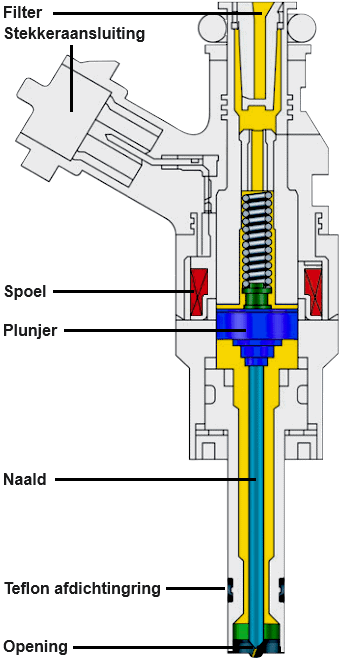
Piezo injector (DI):
Piezo injectors can be used in both petrol and diesel engines. BMW was the first brand to use the piezo technology in petrol engines, but it has stopped with the newer engines.
A piezo injector is part of the high pressure injection. A separate high-pressure pump provides the pressure on the fuel rail. This fuel rail distributes the fuel to all injectors (see picture). Due to the very high pressures, aluminum pipes with cable glands are used. The glands (which are screwed to the pipe and the injectors) must always be tightened with the correct force. This is stated in the repair manual for the relevant engine.
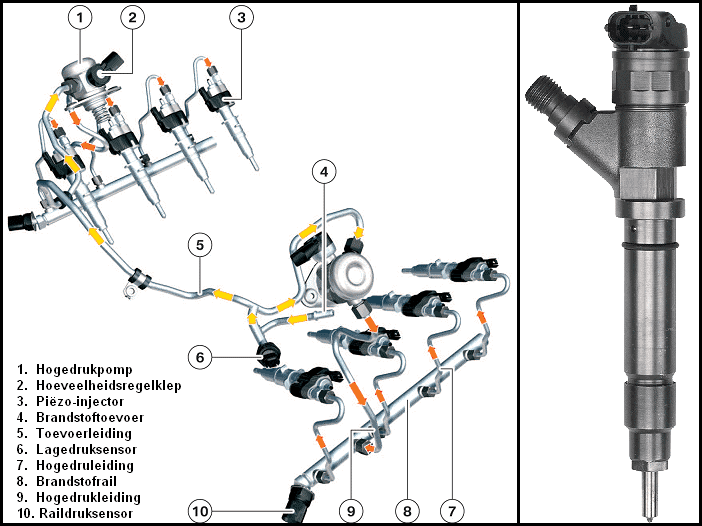
The piezo element in the injector has the property of changing in length when a positive or negative voltage is applied to it. This is used for the injector. As soon as the engine control unit supplies a control voltage of approximately 100 to 150 Volts, the piezo element expands approximately 0,03 mm. This change in length is enough to make a connection between the high and low pressure chamber. The injection starts immediately. The piezo element can switch on and off within a thousandth of a second. Together with the very high injection pressure of up to 2000 bar, this provides very fast and accurate injections. Due to these speeds, several injections can also take place in succession.
Multiple injections during the intake stroke has the advantage that the air-fuel mixture is optimal. Due to the high pressure, the fuel droplets are atomized ultra finely, so that it is even better mixed with the air. Up to 8 injections can take place during the intake stroke. This has positive effects on fuel consumption, power and exhaust emissions.
Direct injection injection strategies:
The injection strategy of direct injection has different variants: wall-guided, air-guided and jet-guided (see the images below). In these situations there is a layered combustion process. This does not apply in all operating conditions.
- Wall guided: The piston directs the fuel cloud to the spark plug. The distance between the spark plug and injector is large. Applied to GDI and HPI engines.
- Air-guided: The air movement brings the fuel cloud to the spark plug. The distance between the spark plug and injector is large. Applied to FSI and JTS engines.
- Jet Guided: The spark plug sits on the edge of the fuel cloud. The distance between the injector and the spark plug is small. Applied to BMW motorcycles.
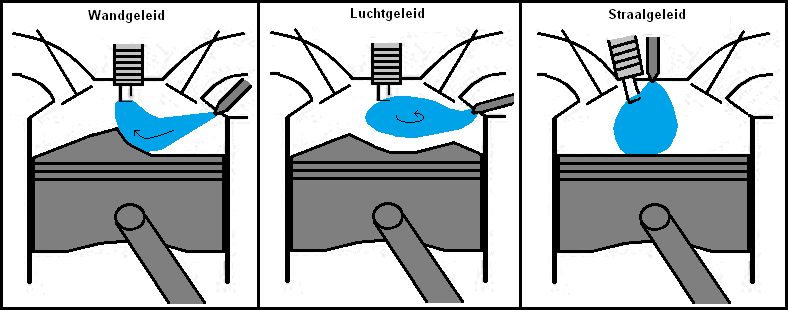
As already indicated, stratified combustion does not occur in all operating conditions with direct injection petrol engines. Jet-guided direct injection engines can run in layers at part load. A layered combustion process means that there are several layers of air in the combustion chamber. Close to the spark plug the lambda value is 1. Further away from there the lambda value gets higher and higher (leaner, so more air). This air provides an insulating layer of air. In a layered process the injection time is later than in the homogeneous process. With the help of a layered injection, the gas valve can be fully opened, so that it throttles the air less. Because the sucked in air is unclogned, it experiences less resistance and can therefore be sucked in more easily. Because the lambda value in the combustion chamber with the layered injection is still smaller than 1 due to the insulating air layer, this does not cause any problems with combustion. During the layering process, fuel consumption decreases.
With a homogeneous mixture, the lambda value is everywhere 1. That means with a petrol engine that the ratio of air and fuel is 14,7:1 (14,7 kg of air with 1 kg of fuel). Any motor can run homogeneously. If it is enriched, the lambda value will decrease and if the mixture is leaned, the lambda value will increase:
<1 = Empire
>1 = Arm
An engine will always fluctuate between rich and poor to keep the catalytic converter working properly. The oxygen sensor sends the data to the engine management system.
At full load, the engine always runs homogeneously. This gives a higher torque than with a layered process. If the engine runs homogeneously, the fuel is injected early. The engine also runs homogeneously when starting from a standstill. A higher starting torque is then present than if the motor were to run in layers.
The characteristic curve below shows the operating situations at different speeds relative to the combustion pressure, with and without the use of EGR.
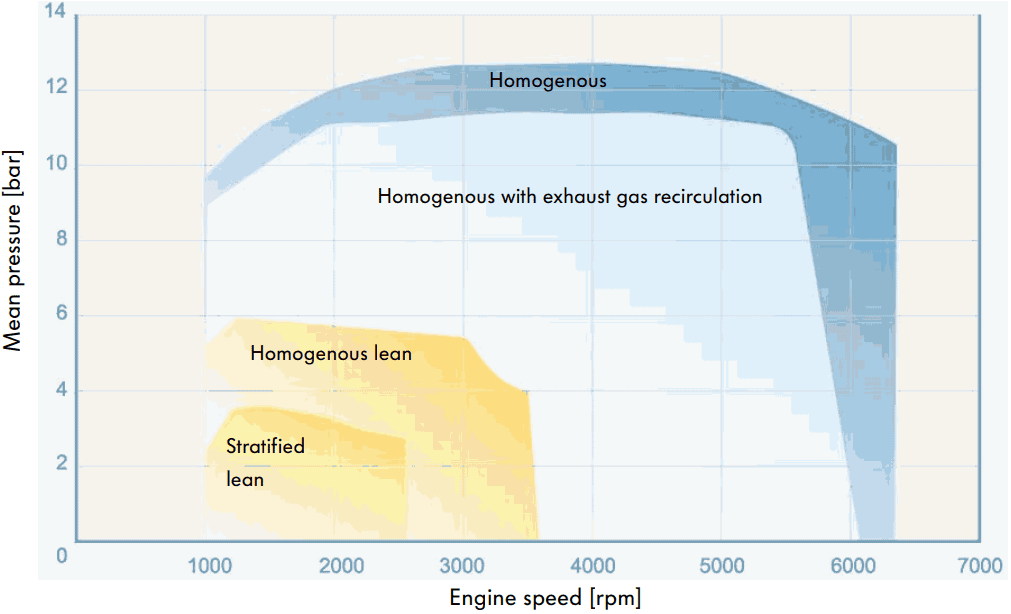
Double injection:
The VAG group uses twin injection petrol engines to meet current emission standards. In dual-injection engines, there are two fuel injection systems: a low-pressure and a high-pressure system.
- The low-pressure system contains MPI injectors that have been used for decades. The MPI injectors are located in the intake manifold and inject at a pressure of 4 to 5 bar into the intake valve;
- The high-pressure system contains high-pressure injectors that inject directly into the combustion chamber with an injection pressure of 150 to 200 bar.
The engine management system determines which injector is controlled.
The following image shows a cross-section of the cylinder head with the two fuel systems.
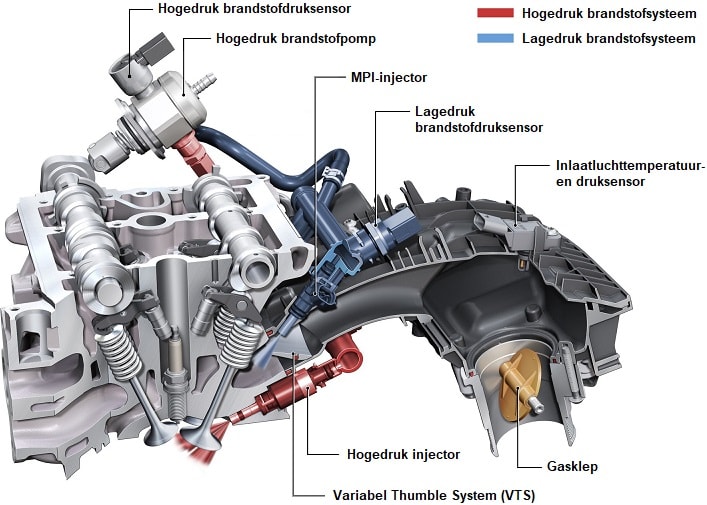
The MPI injection offers a better mixing between air and fuel. The direct injectors are used at idle speed and at full load. With direct injection, better cooling is obtained, allowing a higher compression ratio. However, the mixture of air and fuel is not optimal. This causes more soot emissions. Direct injection engines are nowadays fitted with a particulate filter for this reason. This is not the case with double injection. The “Variable Thumble System”, abbreviated VTS, is a version of a variable inlet manifold through which the airflow experiences a better flow. The “thumble” is an airflow that is brought into a vortex as it enters the cylinder. The air vortex is necessary to properly mix the fuel from the MPI injector with the air.
The double injection in combination with VTS ensures better exhaust emissions. An additional advantage is that the inlet valve is cleaned by the MPI injector. Direct injection engines often suffer from a polluted intake path (intake manifold and inlet valves), which causes the necessary problems such as a limited air supply. In the extreme scenario, the inlet will clog to such an extent that the inlet valve can no longer close properly on the cylinder head and eventually burns because it cannot give off its heat enough.
The dual injection VAG engines are known to have the same direct injection only engines in the United States. The intake manifold is capped. This is because, at the time of writing, environmental requirements in Europe are stricter than in the US, and the manufacturer does not provide such expensive systems for cost reasons for the markets where the emission standards are less strict.
Measuring voltage and current on a multipoint injector:
The oscilloscope can only measure voltage. Test leads can be connected in parallel across the electrical components. It is not possible to measure current in series. The current can be measured using an inductive clamp meter. The Hall sensors in the clamp meter measure the magnetic field and convert it into a voltage. The voltage can be measured with an oscilloscope. In this case there is a conversion factor of 10 mV per Ampere; for every 0,010 volts passed on by the current clamp, this can be converted to 1 A.
The following scope image shows the voltage and current profile of an electromagnetic injector.
- Red: voltage curve;
- Yellow: current flow.
At rest, the voltage is 14 volts. There is now no voltage difference on the plug, so no current flows. The ECU connects one wire to ground to control the injector. The voltage difference causes current to flow through the injector coil.
The yellow line indicates the current flow: the moment the voltage drops to 0 volts, the current build-up begins. Loading the coil takes time. The current does not increase beyond about 0,9 A. Halfway through the current build-up we see a kink in the line: this is the moment when enough magnetism has built up to lift the needle from its seat. The injector starts to inject.
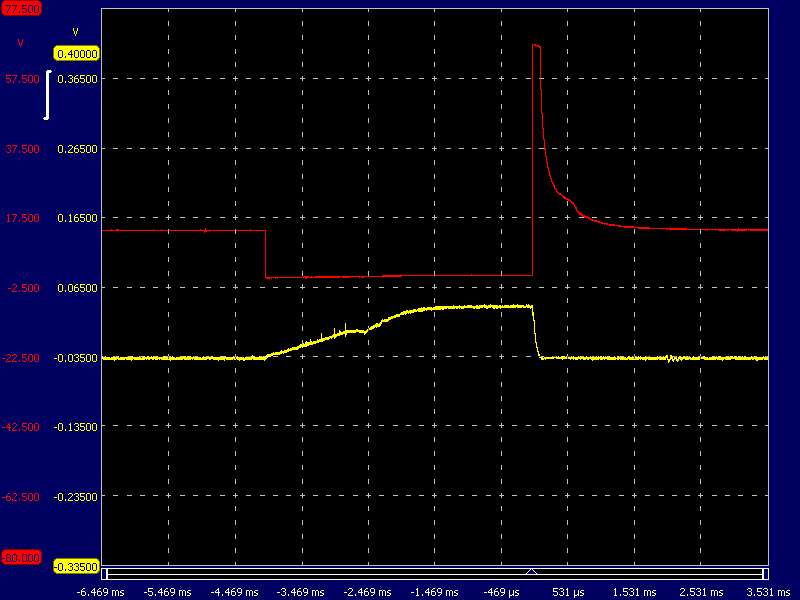
The ECU breaks the ground connection to stop the control. The residual energy in the coil creates an induction voltage of about 60 volts. The injector stops injecting because the spring pushes the needle back into its seat. This can be seen in the scope image by the bump in the voltage signal.
If the engine runs erratically and there is cylinder misfire, it can be due to a number of causes:
- No or poor spark due to a defective spark plug, spark plug wire or ignition coil;
- Restriction in the fuel supply due to a clogged fuel filter, faulty pressure regulator, problem with the fuel pump or injector;
- Loss of compression due to a problem with the piston rings, faulty head gasket or valve seals.
During a diagnosis, a scope can be used to check whether the injectors are still functioning correctly. At the beginning of this section measurements are shown where there was no malfunction. The blue lines indicate as an example what the voltage and current profile of a defective injector would look like.
In the event that the control of the injector is correct, but no kinks are visible in the voltage and current image, it can be concluded that the injector needle is not moving. Because the injector of one cylinder does not participate properly and the other injectors function properly, the images of different injectors can be compared well.
If you gently tap the injector, the injector needle will sometimes come loose. In that case, the motor will immediately run more smoothly and the kinks can be seen again in the scope images. However, this does not guarantee a permanent solution; there is a good chance that the problem will return in a short time. It is necessary to replace the respective injector.
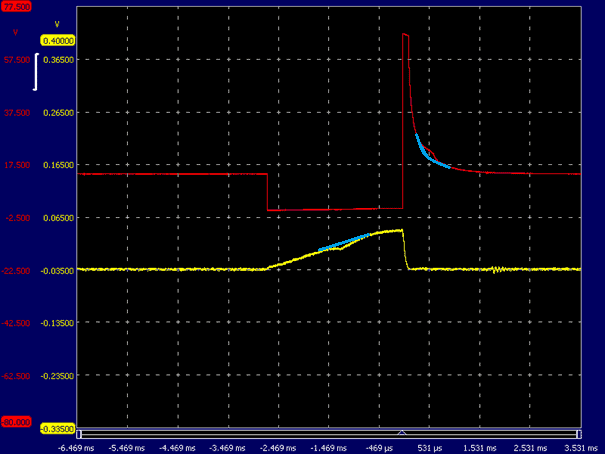
The needle in the injector will not open until the coil has been sufficiently loaded. As a result, the injector does not inject fuel immediately when the ECU starts controlling. After the actuation has ended, the spring presses the injector needle onto its seat. This too takes time. The actuation time is usually not equal to the injection time. The following figure shows the voltage and current curve of the same injector as above, but with an increased speed.
- Start of control: the ECU connects the control wire to ground. Current will open through the coil of the injector. The kink in the flow pattern indicates the moment at which the injector needle opens. Then the current increases a little more and therefore remains constant. The injector needle remains open.
- End of actuation: as already described, we recognize the moment when the injector needle is closed in the voltage picture by the bump.
The actuation takes 4 ms, but the actual injection time is 3 ms. We call the difference between them the “delay”, translated into Dutch as “delay”. So the ECU controls the injector for 4 ms to make it inject 3 ms.
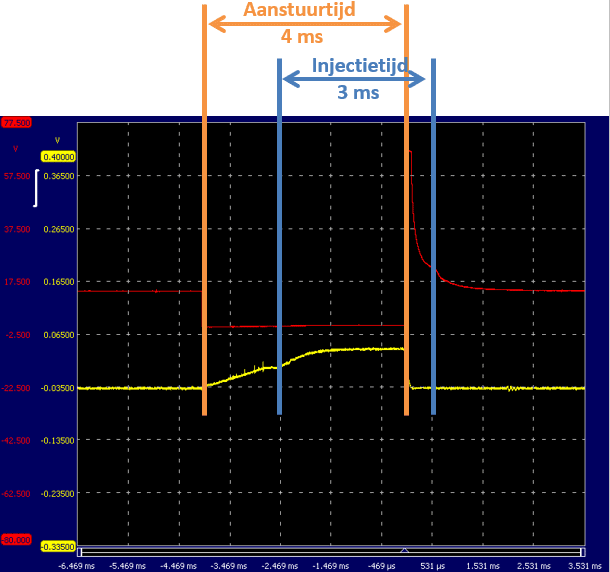
Injection time relative to crankshaft position:
The injection moment can be viewed with the help of an oscilloscope. Channel A (red) is on the injector's ground wire and channel B (yellow) is on the injector's wire crankshaft position sensor connected. While the engine is running, we can use this scope image to determine the injection time and injection time.
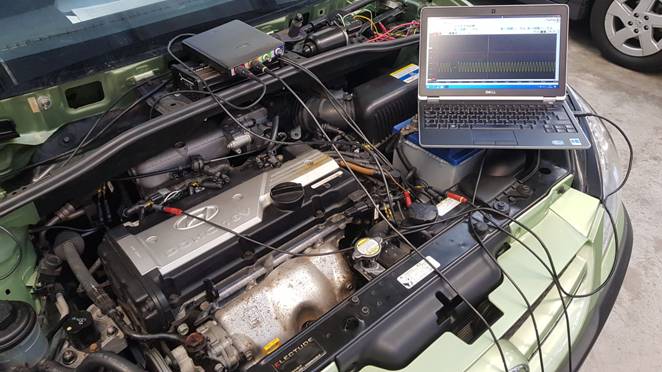
The scope image was taken during idling speed. The red voltage image shows the opening and closing of the injector (see paragraph: Measuring voltage and current curve on a multipoint injector). At the time -2,860 ms, the actuation starts; the voltage drops from 12 volts to 0 volts. This is the point at which the injector coil is grounded and current begins to flow. The injector control ends when the red line rises again. Due to the energy built up in the coil, an induction voltage of more than 60 volts occurs. Then the voltage gradually drops to 12 volts; here the injector is switched off again.
The red alternating voltage comes from the inductive one crankshaft position sensor. Every time the teeth of the impulse wheel rotate past the crankshaft sensor, a sinusoidal alternating voltage is created. The impulse wheel contains 60 teeth, 2 of which have been ground away. The two ground teeth form the reference point, at which the engine management system recognizes that the pistons of cylinders 1 and 4 are between 90⁰ and 120⁰ before TDC (top dead center). After the missing tooth has been recognized, the engine management system has time to (possibly in combination with the camshaft sensor) to determine the correct injection and ignition timing and to control the injector and ignition coil before the piston is at TDC.
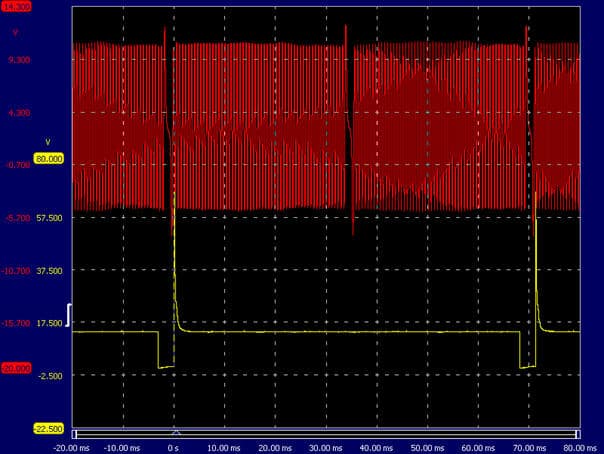
The scope image shows the time when the injection starts; the injection starts at the fourth pulse from the crankshaft sensor. Assuming 60 – 2 teeth are present, after every 6⁰ turns of the crankshaft (360⁰ for 1 revolution / 60 teeth) the injection takes place 24 degrees after the reference point. The missing tooth is 90⁰ BDC, so injection starts (90⁰ – 24⁰) = 66⁰ BDC.
With an increased speed of 2000 rpm, the pulses of the inductive crankshaft sensor are closer together. The frequency of this signal is translated by the engine management system into a speed. Depending on the speed, the load (measured by the MAP sensor) and the temperatures of the charge air and coolant, the required injection time is determined. The injection time is earlier and the injector is longer on ground: the injector injects earlier and longer.
From the start of the actuation to the trigger point (arrow at the level of the injector shutdown), the actuation is approximately 5,2 ms. The time that the injector is actuated is not equal to the actual injection (see the previous paragraph).
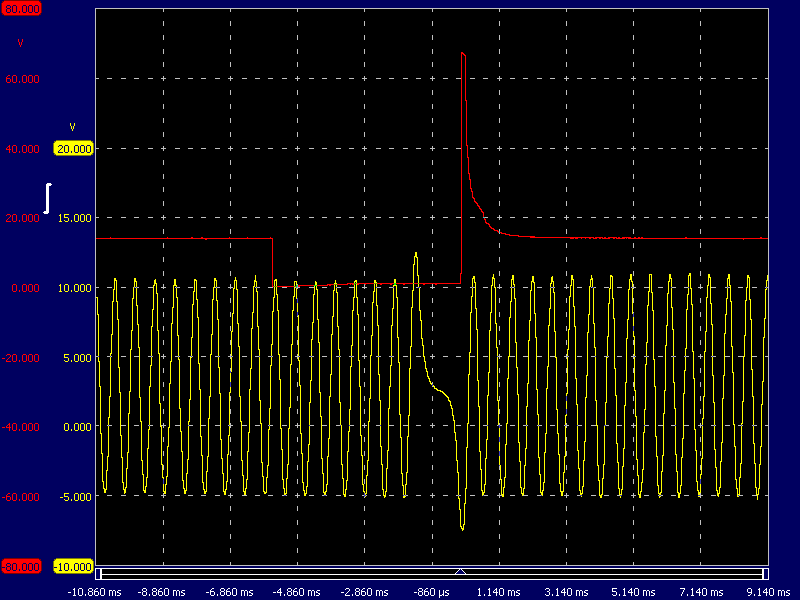
In the following scope image, the inductive crankshaft signal is red, and the injector signal is yellow. When increasing the speed to about 3000 rpm, two injector controls can be seen. It can clearly be seen that the fuel injection of cylinder 1 takes place with every second crankshaft rotation.

Current limitation in the ECU:
As emerged from the measurements in the section “Measuring voltage and current profile on a multipoint injector”, there is a delay between actuating and actually opening the injector needle. In this case, it takes 1,5 ms to open.
The injector needle would open faster if the current through the coil increased faster. The current intensity depends on the resistance of the coil: the lower the resistance, the faster the current build-up. The high-impedance injectors used in the measurement engine have a resistance of 16 Ohms. At on-board voltage of 14 volts, a small current will flow:

The current is enough to open the injector needle, but not too high so that it would get too hot due to too high a power:
Because only a low power is built up, it is not necessary to use a current control. This would be necessary for low-impedance injectors.
- Low-ohmic injectors have the advantage that the current build-up quickly increases from the start. This results in a quick opening of the injector needle, so little delay.
- Low ohm injectors have a resistance of about 2,8 ohms. Due to the low resistance, a high current will flow:

The power also increases sharply:
The power consumption is almost seven times higher than with the high-impedance injectors. If the current increases too much, heat develops in the injectors and in the output stage of the control unit. To limit the current, the voltage is switched on and off a number of times in a short time. After the injector needle has been opened, it takes little energy to keep the needle open. The current decreases during switching on and off. This gradient can be seen in the scope image.

Determination of the required amount of fuel:
The manufacturer has determined the required amount of fuel in various map fields that are stored in the ROM memory of the ECU. It engine management system reads from these charts how much fuel is needed without corrections. This of course depends on the engine speed, temperature and load. The most important parameters for determining the correct fuel quantity are explained in this section as the VE table and AFR table.
VE table:
The VE table represents volumetric efficiency and air/fuel ratio at each engine speed and intake manifold pressure. The volumetric efficiency is the ratio between the measured amount of air that fills the cylinders and the amount of air that would fill the cylinder in a static situation, depending on the speed and the intake manifold pressure. The values in the table are used by the ECU to determine the current air mass and thus the degree of filling. This data is used to calculate the amount of fuel to be injected.
This theoretical approach deviates from reality. The engine specifications have not yet been taken into account here. Think of the valve diagram (valve overlap, or possibly variable valve timing), the air resistance in the inlet path, etc. That is why a correction factor is applied that gives a deviation from the linear relationship. The correction factor is shown in the image above by the broken dashed line. The curve indicates to what extent the linear relationship is correct. At a pressure of 60 kPa, the deviation is about 50% with respect to the line showing the linear relationship. The correction factor can be formed to a percentage.
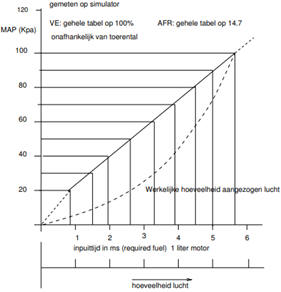
In a VE table, the percentage associated with the underpressure in relation to the speed is indicated in each cell. This percentage will be highest at the speed at which the torque is highest. After all, there the engine is most efficient because the engine fills the best.
The values in the VE and AFR tables later in this section are derived from the torque and power curve of a 1.8 20v VW Golf engine.
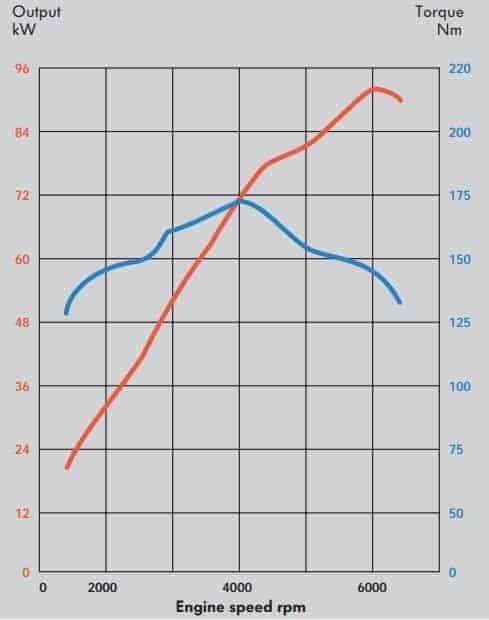
The images below show the VE table as a fill-in table and the three-dimensional representation created using the torque and power curve in the “TunerStudio” program. This program is mainly used to provide a programmable ECU such as the MegaSquirt or Speeduino with software. For more information: see the pages about the Mega Squirt project.
The vertical axis shows the MAP (Manifold Air Pressure) from 15 kPa (a lot of negative pressure) to 100 kPa (the outside air pressure). The MAP indicates the engine load. The horizontal axis indicates the engine speed between idle and maximum engine speed.
The cells in the VE table show the fill rate of the motor. In other words; how efficient the engine is at a given speed and load. Around the rpm where the torque is highest, (around 4200 rpm) the motor is most efficient; the percentages are highest here. This is where the engine "fills" best. With the application of techniques that increase the filling degree, such as variable valve timing, intake manifold adjustment, or the use of a turbo, this benefits the percentages.
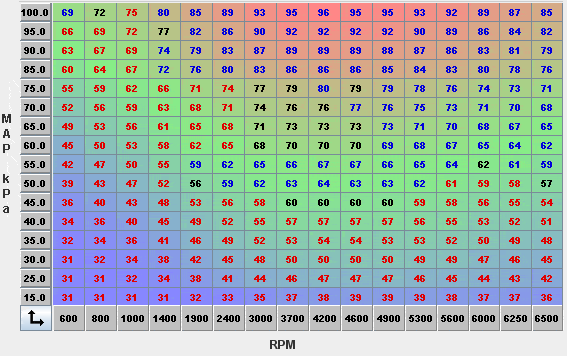
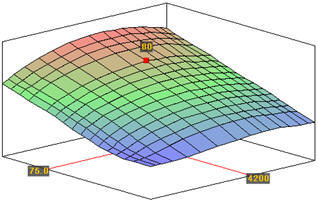
AFR table:
The required air / fuel composition is recorded in an AFR table. AFR is the abbreviation of “Air Fuel Ratio”. At a stoichiometric mixing ratio (lambda = 1), 14,7 kg of air is needed to burn 1 kg of gasoline. A stoichiometric mixture is not desirable in all situations.
- A lean mixture benefits fuel consumption;
- A rich mixture allows for higher power.
Enrichment takes place when the engine has to deliver more power (P). A richer mixture also provides cooling. Enriching to λ = 0,8 means that a mixing ratio (AFR) of 11,76 kg of air to 1 kg of gasoline applies. So there is less air available to burn 1 kg of fuel than with a stoichiometric mixture. A lean mixture, on the other hand, gives a more favorable fuel consumption (be), but again gives more chance of pinging. The enrichment or depletion of the mixture must always remain within the combustion limits.
During idling, the speed is between 600 and 900 rpm. The gas valve is almost completely closed and the negative pressure is high: it is between 25 and 40 kPa. The mixture is stoichiometric (14,7:1) in this speed range.
At part load, the engine speed will have increased to 4200 rpm. The throttle is opened further, so the underpressure in the intake manifold drops to 40 – 75 kPa. With increasing engine load, the negative pressure decreases; there is enrichment (AFR of 13:1). A lean mixture is possible at low engine load. At full load, the throttle is fully open. The negative pressure drops to 100 kPa (the outside air pressure) and maximum enrichment takes place (12,5:1).
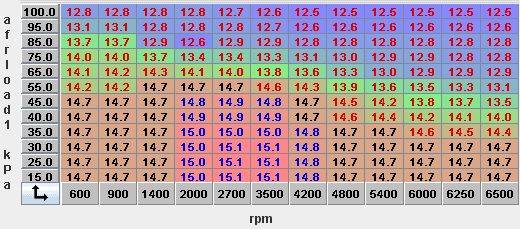
The lambda value affects not only power and fuel consumption, but also exhaust emissions. A richer mixture ensures a lower NOx content, but also higher CO and HC emissions. With a leaner mixture, the fuel particles are further apart, so that the combustion is no longer optimal; As a result, HC emissions also rise.
When using a catalytic converter, it is desirable to have the injection run continuously, alternately rich and lean. With a rich mixture, CO is formed as a result of an oxygen deficiency, with which the catalyst reduces the NOx. A lean mixture contains a surplus of oxygen, with which CO and HC are oxidized.
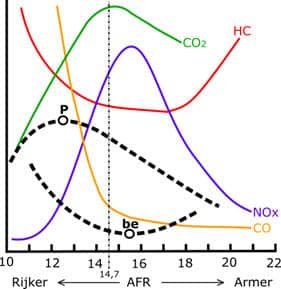
The control unit determines how much fuel to inject. In the first place, the basic injection data is read from the characteristics. The values from, among other things, the VE and AFR tables are included in the calculation for the injection quantity. The following values determined by the manufacturer are also taken into account:
- enrichment dependent on coolant and charge air temperature;
- short-term acceleration enrichment when (quickly) opening the throttle;
- correction due to variation in on-board voltage.
In addition to these determined values, the voltages sent by the lambda probe to the control unit are carefully taken into account. These voltages depend on the oxygen content in the exhaust gases. This is a variable factor that changes continuously. The input of these sensor voltages are referred to as “fuel trims" incorporated.
How the values of the VE and AFR table and the other mentioned settings are determined is described on the pages of the performed Mega Squirt project.
